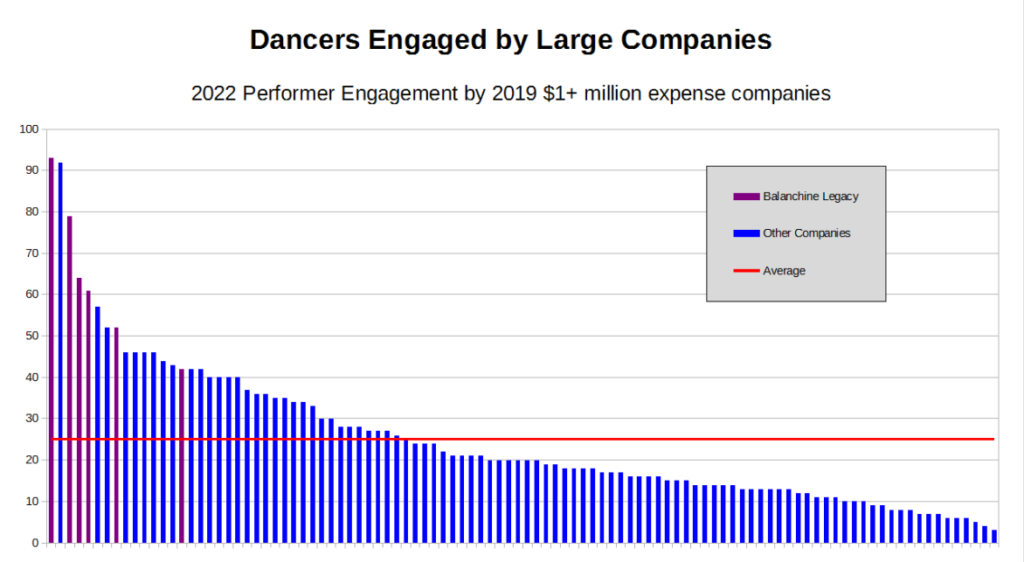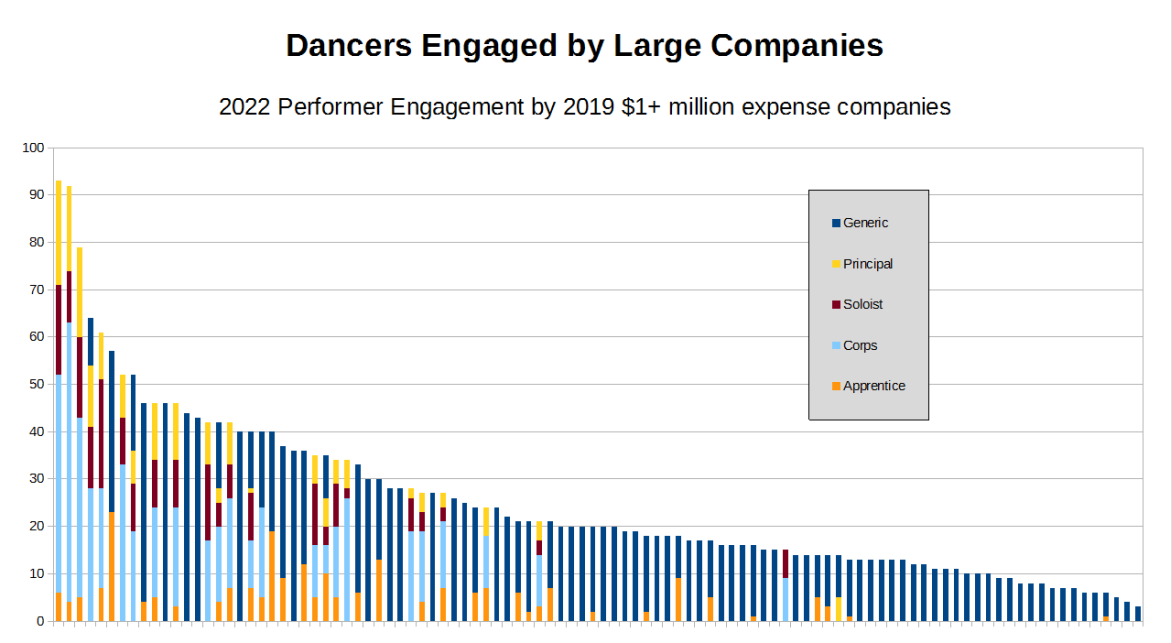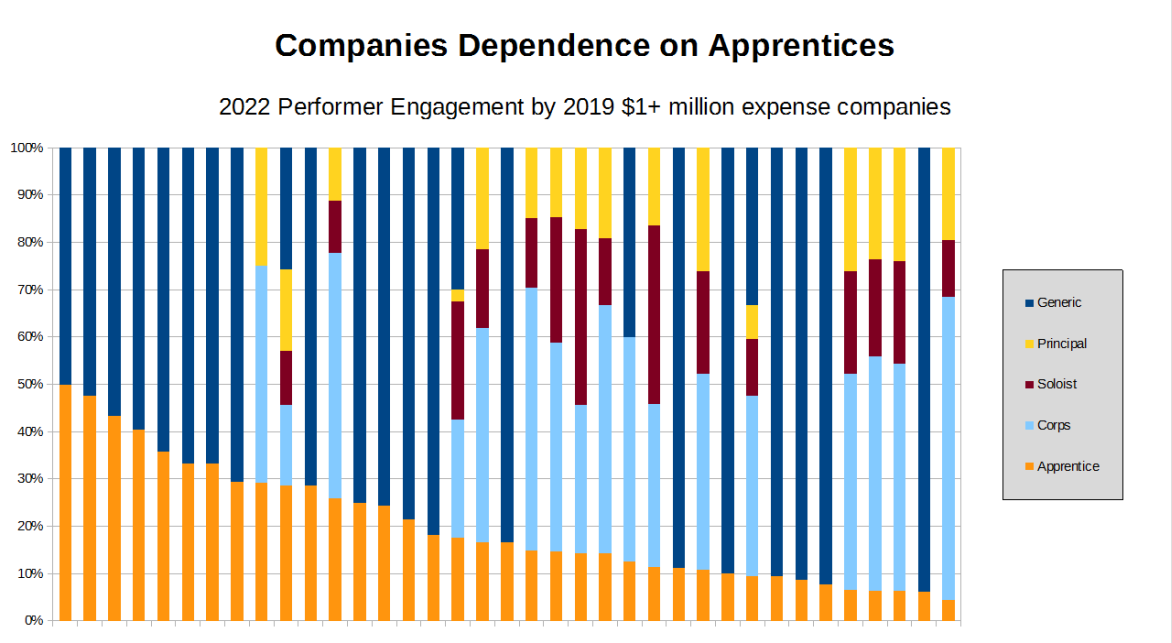The one “job” (urgh…) that is critical to a dance company is… dancer. Even if it’s just one dancer, without that person, it may be a company (of some sort…), but it’s not a dance company. At that end of the spectrum, a single person does everything. Today we’ll look at the other end.
Expanding the scope a bit from some previous work, I offer a brief look at engagement prospects within the million-plus-dollar non-profit dance company world. Based on 2019 data, there are 116 of these companies in the United States. I found information about the company dancers for 102 of them during the 2022 Nutcracker season. This approach does get a little tricky – I’m using one time period (pre-pandemic 2019) to pick companies, and another (December 2022) to count dancers, and the number of dancers active with a company can vary instantly. That pandemic window probably also has some impact on this specific question, but I think this will work to a rough approximation (eventually reasonably complete 2022/2023 financial data will become available, and maybe I can revisit this).
The $1 million cutoff is also arbitrary, but at this level, the dancers probably have few demands beyond learning their choreography and delivering a polished performance to an audience. I figure this is about as “dance” as a “dance career” can be.
Counting Bodies
Combined, those 102 companies engaged roughly 2560 dancers – about 25 dancers in each (range is 3 to 93).

The largest companies (by number of performers) are (of course… also by budget) New York City Ballet (NYCB) and American Ballet Theater (ABT), each engaging more than 90 dancers.
The six Balanchine-legacy companies represent more than 15% of all dancers engaged by the $1+ million companies (occupying four of the largest five companies by company size…). Among the other solidly-Balanchine-influenced is Miami City Ballet, whose artistic director Lourdes Lopez is not just a NYCB alum, but served as Executive Director of the George Balanchine Foundation. Pacific Northwest Ballet (PNB), under the artistic direction of Peter Boal and former co-artistic direction of Francia Russell and Kent Stowell (all NYCB alums…), came to New York City in 2013, and in at least one reviewer’s opinion, out-Balanchined Balanchine’s own company, on Balanchine’s own turf.
[New York] City Ballet’s performances of this [“Concerto Barocco“] and “Agon” certainly don’t project in the David H. Koch Theater as these performances do at the smaller City Center. And though City Ballet has some fine individual dancers, it is less unified in its understanding of Balanchine.
Alastair Macauley, “Performers from the West Coast Serve Up Balanchine,” New York Times, 14 February 2013.
There are many other companies in this group that have some sort of Balanchine legacy – the current artistic director (Susan Jaffee) of ABT is a School of American Ballet (SAB) alum (though probably not so deeply Balanchined…). Other current artistic directors that are NYCB/SAB alumni include Zalman Raffael, Gen Horiuchi, Steven Wistrich, Melissa Barak, Ib Anderson, Edward Liang, Ethan Stiefel, Maria Kowroski, and even Brenda Way.
I’m sure there are more, but these put another 450 (18%) of jobs in a sort of indirect-Balanchine-legacy category, meaning at least a third of all engagement at this level operate under some degree of Balanchine influence.
14 of these million-dollar companies engage fewer than 10 dancers – Charlottesville Ballet, Northwest Dance Project, BodyVox, BANDALOOP, Trisha Brown Company, Stephen Petronio Company, Dance Brigade, Pilobolus, Urbanity Dance, AXIS Dance Company, Urban Bush Women, STREB,and Minnesota Dance Theater.
Within these companies, we have here just under 200 Principals (8%), just over 200 Soloists (8%), just over 500 Corps (20%), and about 230 Apprentices (9%) – leaving a bit more than 1400 “generic” dancers.

A Digression on Apprentices
Only about a third (37) of these companies engage “apprentices,” which are technically “bound to work in return for instruction.” I’m sure the actual terms of engagement vary from company to company – but apprentices are most likely to be in a situation where they are unpaid or even paying for the opportunity to perform.
It’s not a fair assumption, but removing the apprentices leaves only 2330 dance positions at these companies.
Those companies that describe some of their dancers as apprentices average about one-fifth (20%) apprentices, but it ranges as high as 50% (Madison Ballet), and as low as 4% (American Ballet Theatre).

The companies most-dependent on apprentices are Madison Ballet (50%), Saint Louis Ballet (48%), Grand Rapids Ballet (43%), Nashville Ballet (40%), Parsons Dance (36%), Alabama Ballet (33%), and Ensemble Español (33%). Interestingly, all of these have steered away from the “corps/soloist/principal” language for their other dancers.
The number of apprentices may also meaningfully (or not…) reflect the company’s anticipated “replacement requirements” – a company may keep a certain number of apprentices “in the pipeline” as a way to ensure that the show goes on when dancers of higher rank leave. Strategies about this vary, or there may be no strategy at all. Something to explore…
Capacity (from a Great Distance)
Of course, the meaning of “Principal,” “Soloist,” “Corps,” and “Apprentice” will vary a bit, particularly as you wander further away from very traditional ballet structures… and the terms of engagement will very even more. NYCB dancers are union-represented (AGMA) and have 9+ month contracts. Charlottesville Ballet contracts were closer to 6 months – and that’s just contract length.
One potential approach to measuring capacity is annual company expenses per dancer. As usual, this is not “fair,” because some companies have huge operating expenses for things like buildings and schools, and others just don’t. Some have second companies, and most don’t. Some spend a lot on production, and some don’t. Just to poke around this a bit…
On average, these companies spend about $250,000 per year per dancer (not all of that, or even most of that, goes to the dancer….). At the highest end, we have NYCB, supporting 93 dancers with annual expenses around $92 million – just shy of $1 million per dancer. Alvin Ailey American Dance Theater is right there too (46 dancers on a $45 million budget). After those two, it drops quickly – San Francisco Ballet‘s expenses-per-year-per-dancer is a bit less than $720,000 for its 79 performers.
At the other extreme is City Ballet of San Diego, which manages to keep 37 dancers (16 company members, 12 studio company members, and 9 apprentices) engaged while spending just $1.1 million – less than $30,000 per year per dancer.
Opportunity vs. Tenacity
Only a fraction of these 2560 (or 2330, if you discount apprentices…) opportunities is available in any given year. Getting one is not nearly as challenging as the small handful of artistic director openings (I used a higher $5 million cutoff for that analysis), but still very few openings at this level.
Naturally, once someone has one of these positions, they are very likely to hang on to it as long as possible – until promotion or career-ending injury do they part. Teresa Reichlen stayed with NYCB for 22 years, from apprentice to principal, retiring in February 2022. Susan Jaffee also managed a 22-year stage career (1980-2002) at ABT. These are the two largest (and best resourced) companies in the United States. They probably take very good care of their performers, which may contribute to these long stage careers, but as the length of the career in years approaches the number of performers in the company (average 25…), the number of openings approaches one per year – and there are only about 116 million-dollar companies.
Hopefully, all this goes some distance toward appreciating just how extraordinary these “jobs” (urgh…) are.